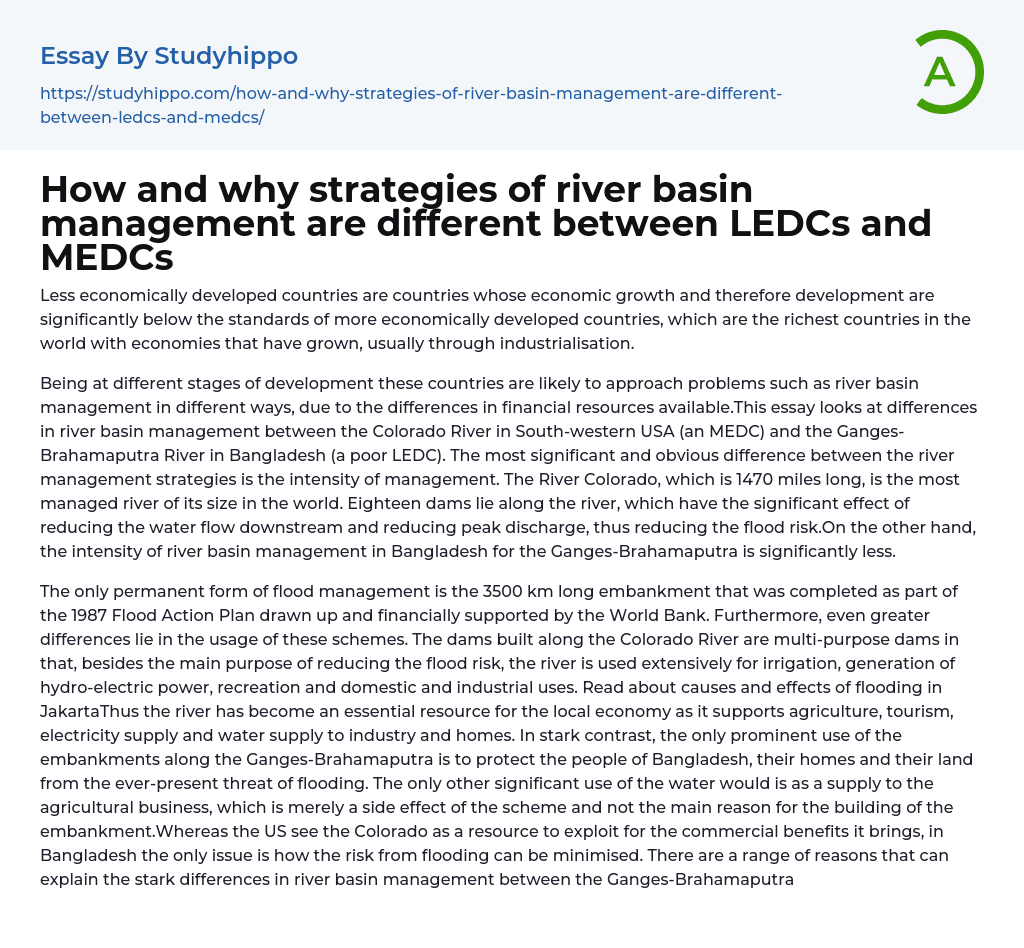

The Economic Divide: Comparing Developed and Less Developed Countries
Less economically developed countries (LEDCs) are countries whose economic growth and development are substantially below the standards of more economically developed countries (MEDCs), which are the world's wealthiest countries with economies that have typically grown through industrialization. Due to differences in financial resources available, LEDCs are likely to approach issues such as river basin management in different ways. This essay examines the disparities in river basin management between the Colorado River in South-western USA (an MEDC) and the Ganges-Brahmaputra River in Bangladesh (a poor LEDC).
The most noticeable difference between the river management strategies lies in the intensity of management. The Colorado River, spanning a length of 1470 miles, is the most extensively managed river of its size globally. Along the river, eighteen dams have been constructed, which significantly reduce downstream water flow and peak discharge, thus mitigating flood risks.
In contrast, river basin management in Bangladesh for the Ganges-Brahmaputra experiences sign
...ificantly less intensity. The only permanent flood management measure is a 3500 km long embankment, completed as part of the 1987 Flood Action Plan devised and financially supported by the World Bank.
Furthermore, there are significant differences in the usage of these schemes. The dams built along the Colorado River serve multiple purposes, including flood risk reduction, irrigation, hydro-electric power generation, recreation, and domestic and industrial uses. Read about
causes and effects of flooding in Jakarta
.
This makes the river a crucial resource for the local economy as it supports agriculture,
tourism,
electricity supply,
and water supply to industry and homes. In contrast,the main purpose of the embankments along the Ganges-Brahamaputra is to protect the people of Bangladesh,
their homes,
and thei
land from constant flood threats.
The embankment was built primarily to reduce the risk of flooding rather than to support agriculture. In contrast, the United States sees the Colorado River as a valuable resource for commercial purposes. Various factors, such as politics and socio-economic conditions, contribute to the differences in managing these river basins. Political factors are particularly influential, notably Bangladesh's limited control over the Ganges River. Bangladesh is located on the delta and lower reaches of the river, making it highly susceptible to flooding due to its restricted political authority over this waterway.
Despite being a country, Bangladesh has limited control over the actions of India and Nepal along the river or in its upper catchment area. This lack of control was evident during the 1988 floods in Bangladesh when the Indian government opened the flood gates to the Farakka dam, worsening the already severe flooding. Furthermore, Bangladesh faces water scarcity during dry seasons as India continuously extracts more water from the Ganges. These instances highlight Bangladesh's limited power over the river and contribute to their inadequate river management. In contrast, the political situation in America is entirely different.
The majority of the River Colorado, more than 90%, flows within the borders of America, while only a small portion, around 100 miles, flows through Mexico. This ensures that the United States holds absolute authority over the river and has the liberty to construct dams or carry out various projects along its path. In contrast, Bangladesh lacks the political influence to exert similar control. The differences in river basin management schemes between these two nations primarily stem from socio-economic factors, notably finance. The USA boasts one of
the largest economies globally, second only to Japan.
Consequently, while the United States has the financial means to build dams and implement various schemes for river management, Bangladesh, being one of the world's poorest countries, lacks the funds to conduct extensive research and develop sophisticated management strategies like its more affluent counterpart. Additionally, the USA, being a leader in technological progress, possesses the expertise to research and develop advanced management schemes, which Bangladesh, lagging behind in terms of technological progress, cannot afford to finance despite having experts in the field. The disparities in river management strategies between the two countries are a clear reflection of their differing levels of success in mitigating flood risks. Through intensive management efforts since 1935, the Colorado River's peak discharge has been reduced by more than half, transforming it from a volatile and unpredictable river into a reliable and consistent one. In contrast, flood defense schemes in Bangladesh have been minimal, leaving the country vulnerable to severe flooding and constant risks to both homes and lives.
- Stream essays
- Leadership and Management essays
- Change Management essays
- Project Management essays
- Knowledge Management essays
- Operations Management essays
- Quality Management essays
- Risk Management essays
- Scientific Management essays
- supply chain management essays
- Performance Management essays
- Time Management essays
- Brand Management essays
- Total Quality Management essays
- Risk essays
- Manager essays
- Leadership essays
- Business Ethics essays
- Board Of Directors essays
- Product Management essays
- Comparative Analysis essays
- Decision Making essays
- Dispute Resolution essays
- Stress Management essays
- Business Management essays
- Brand Equity essays
- Branding essays
- Nike, Inc. essays
- Market share essays
- Razor essays
- Being A Leader essays
- Servant Leadership essays
- Leadership Experience essays
- Leadership Qualities essays
- Incentive essays
- Bottled Water essays
- Bangladesh essays
- China essays
- Hong Kong essays
- India essays
- Japan essays
- Kuala Lumpur essays
- Malaysia essays
- Manila essays
- Pakistan essays
- Philippines essays
- Singapore essays
- Vietnam essays
- Vietnamese essays
- Air Pollution essays



